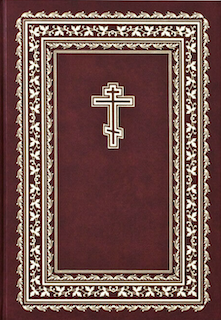This is last of a 4-part series about the importance
of Holy Scripture and Holy Tradition based on the the booklet
Which Came First: The Church or the New Testament?
by Fr. A. James Bernstein
[To read the full unabridged booklet without comment from the author of this blog post, please do see the link above.]
How did the New Testament canon develop over time?
Historical New Testament canon development
Second Century
- “It is believed the oldest legitimate list of New Testament books is the Muratorian Canon dating from the late second century (180 BC).”
- The Muratorian Canon excludes:
- Hebrews
- James
- 1 Peter, 2 Peter
- The Muratorian Canon includes:
- the Apocalypse of Peter
- the Wisdom of Solomon
Third Century
- Around AD 200 (about 170 years after the death and resurrection of Christ) we first see the term “New Testament” used, by Tertullian.
- Origen mentions some churches that rejected 2 Timothy because it references a “secret” writing – the Book of Jannes and Jambres, derived from Jewish oral tradition (see 2 Timothy 3:8).
- The Book of Jude was also considered suspect by some churches because it includes a quotation from the apocryphal book, The Assumption of Moses, also derived from Jewish oral tradition (see Jude 9).
Fourth Century
- Eusebius, Bishop of Caesarea (a.k.a the “Father of Church History”) lists the following books as disputed and he personally altogether rejects canonicity of Revelation (The Apocalypse):
- James
- Jude
- 2 Peter
- 2 John
- 3 John
- Codex Sinaiticus, the oldest complete New Testament manuscript we have today, was discovered in the Orthodox Christian monastery of Saint Catherine on Mount Sinai. It contains all of the books we have in the modern New Testament, but also includes Barnabas and The Shepherd of Hermas.
- Emperor Constantine, frustrated by the ongoing controversy between Christians and Arians concerning the divinity of Christ, pressed for a clearer definition and a closing of the New Testament canon, in an effort to help resolve the conflict and bring religious unity to his divided Empire, but the canon was not determined so simply.
Fifth Century
- Despite the efforts of Constantine to close the canon, the Codex Alexandrinus is found to include 1 and 2 Clement indicating that the 27-book New Testament canon of today was not yet fully received.
New Testament Canon in the Church Councils
Fr James explains critical role of Church councils in the formation of the New Testament canon as follows [emphasis mine]:
- “With the passage of time the Church discerned which writings were truly apostolic and which were not. It was a prolonged struggle, taking place over several centuries…”
- “As part of the process of discernment, the Church met together several times in council. These various Church councils confronted a variety of issues, among which was the canon of Scripture. It is important to note that the purpose of these councils was to discern and confirm what was already generally accepted within the Church at large…”
- “The councils did not legislate the canon so much as set forth what had become self-evident truth and practice within the churches of God…”
- “The councils sought to proclaim the common mind of the Church and to reflect the unanimity of faith, practice, and tradition as it already existed in the local churches represented…”
- “The councils provide us with specific records in which the Church spoke clearly and in unison as to what constitutes Scripture.”
- Among the many councils that met during the first four centuries, two are particularly important in this context:
- The Council of Laodicea
- met in Asia Minor about AD 363
- this is the first council which clearly listed the canonical books of the present Old and New Testaments, with the exception of Revelation (The Apocalypse of Saint John)
- stated that only the canonical books it listed should be read in church.
- its decisions were widely accepted in the Eastern Church.
- The third Council of Carthage
- met in North Africa about AD 397
- this council, attended by the Blessed Augustine, provided a full list of the canonical books of both the Old and New Testaments.
- the twenty-seven books of the present-day New Testament were accepted as canonical.
- the council also held that these books should be read in the church as Divine Scripture to the exclusion of all others.
- this Council was widely accepted as authoritative in the West.
- The Council of Laodicea
Conclusion
“..as Christ Himself was born, grew, and matured, so also did the written Word of God, the Bible. It did not come down whole-plop-from heaven, but was of human origin as well as divine. The Apostles did not merely inscribe the Scriptures as would a robot or a zombie, but freely cooperated with the will of God through the inspiration of the Holy Spirit... As Paul writes, the Body is “the church of the living God, the pillar and ground of the truth” (1 Timothy 3:15). The Church is the Living Body of the Incarnate Lord. The Apostle does not say that the New Testament is the pillar and ground of the truth. The Church is the pillar and foundation of the truth because the New Testament was built upon her life in God. In short, she wrote it! She is an integral part of the gospel message, and it is within the Church that the New Testament was written and preserved.”
– Fr James Berstein
More Information
- https://orthodoxwiki.org/Gospels
- http://orthodoxinfo.com/inquirers/ntcanon_emergence.aspx
- https://www.ocf.net/the-new-testament-canon/
- https://www.oca.org/orthodoxy/the-orthodox-faith/doctrine-scripture/sources-of-christian-doctrine/tradition
- https://www.orthodoxroad.com/scripture-vs-tradition/
- “Which Came First the Church or the New Testament?” by Fr James Bernstein (source for this blog post)

